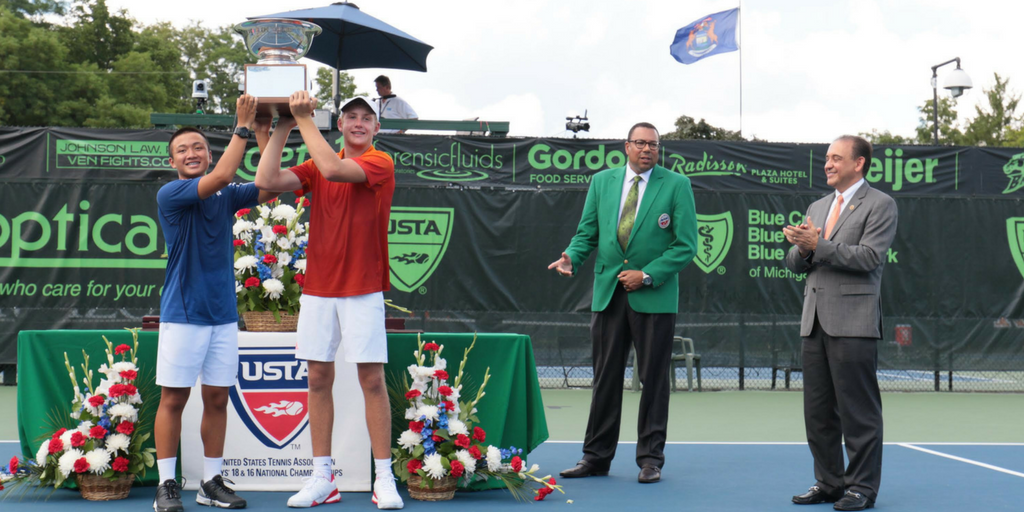The Ton family of Milpitas, California, north of San Jose, is a tennis clan if ever there was one. Father N.T. Ton, a research scientist in the medical-device field, and his wife, Melissa Phuong, both play recreational ball. The family, of Vietnamese extraction, includes two daughters who’ve had college varsity careers and a son about to start one. Several of their cousins play. “I’ve spent 30 years in junior tennis,” N.T. Ton says.
Eldest daughter Christina played at Manhattan College in New York City and captained the team for, impressively, three years. Her sister Stefanie attended the U.S Naval Academy in Annapolis, where, as a senior, she, too, captained the tennis squad. “Our kids work hard and they deserve all the credit for their successes,“ Ton says. “But as parents, Melissa and I couldn’t have been more proud when Manhattan College and Navy would say to us, as they often did, ‘Thank you for sending your daughters here.’ ” Son
Andrew, now 17, will enroll at Annapolis this fall. Prominent coaches like Nick Saviano and Robert Lansdorp have mentored the Ton offspring.
“Tennis is a great sport to raise a kid with,” says Ton. “My philosophy is, first, do your best to raise your kid to be a good person, a decent human being. And in tennis, you can learn all the variables that matter in life.”
"Tennis is a great sport to raise a kid with."
When the girls were growing up on the courts, “I didn’t like the USTA ranking system,” Ton recalls. “We never chased points, or rankings, for the girls. That would have meant picking and choosing which tournaments you play. But the USTA kept changing the points awarded at different tournaments.” As far as comparing potential college recruits goes, sites like tennisrecriuting.net had some information, “but they only compare players within the same age group,” says Ton.

Instead, Ton invented his own way of figuring out where the girls stood in the tennis firmament, both as juniors and prospective collegians. “I wrote an algorithm for my daughters,” he says, “and used the women varsity players at U.C. Santa Clara, U.C. Berkeley, and Stanford as benchmarks. I took the results and made up a one-to-ten scale to get an idea of how my girls stacked up. When UTR
came out, I said, ‘Wow, this is what I was looking for.’ ”
"With just a couple of clicks, a player can have a reasonable idea if he or she would fit in a program, and a college coach can have a reasonable assessment of someone’s level of play."
Ton was well ahead of most tennis parents in catching on to UTR, and as a result he became a kind of oracle among that group. “When UTR came out, I could tell you before the match that this top seed with a low UTR was going to lose to a lower seed who had a better UTR,” Ton says. “And she would! The other parents called it an upset, but to me, it was not an upset. I went to a lot of tournaments, and frequently, the high seeds were kids who had happened to play a lot of tournaments, but weren’t really playing high-level tennis.”
With his youngest, Andrew (now at Bellarmine College Prep in San Jose), Ton has had the benefit of UTR to help guide the boy’s tennis career all along. USTA’s Northern California section runs level-based junior tournaments, using UTRs to select entrants and seed draws. The system also helps find practice partners. “You can tell right away with UTR if a player can give Andrew a competitive practice,” Ton says. “You have a good idea of their level of play.”

NT Ton with his son Andrew (UTR 12.92) and wife Melissa
Furthermore, “UTR is a meaningful college recruiting tool, not only for players and parents but also for college coaches,” Ton adds. “With just a couple of clicks, a player can have a reasonable idea if he or she would fit in a program, and a college coach can have a reasonable assessment of someone’s level of play. I am especially impressed and excited to know that some college coaches now use UTR to schedule future competitions.”
No need to reinvent the wheel! Access UTR with a free membership here.
Featured Image: Kalamazoo 2016 Doubles Champions Andrew Ton and Max Wild
 Instead, Ton invented his own way of figuring out where the girls stood in the tennis firmament, both as juniors and prospective collegians. “I wrote an algorithm for my daughters,” he says, “and used the women varsity players at U.C. Santa Clara, U.C. Berkeley, and Stanford as benchmarks. I took the results and made up a one-to-ten scale to get an idea of how my girls stacked up. When UTR
Instead, Ton invented his own way of figuring out where the girls stood in the tennis firmament, both as juniors and prospective collegians. “I wrote an algorithm for my daughters,” he says, “and used the women varsity players at U.C. Santa Clara, U.C. Berkeley, and Stanford as benchmarks. I took the results and made up a one-to-ten scale to get an idea of how my girls stacked up. When UTR  NT Ton with his son Andrew (UTR 12.92) and wife Melissa
NT Ton with his son Andrew (UTR 12.92) and wife Melissa

